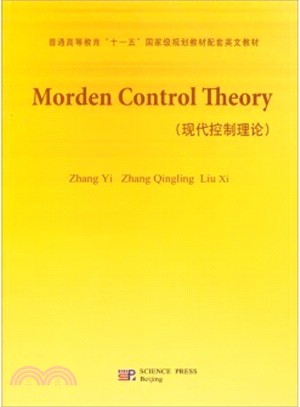Modern Control Theory(簡體書)
商品資訊
系列名:普通高等教育"十一五"國家級規劃教材配套教材
ISBN13:9787030412522
出版社:科學出版社
作者:張翼
出版日:2021/09/07
裝訂/頁數:平裝/175頁
規格:23.5cm*16.8cm (高/寬)
商品簡介
目次
商品簡介
學習專業英語是數學專業本科生的必修課程。如果使用純英文教材,學生接受起來比較困難。如果是純粹的中文教學方式又不能與國際化現代教學的實際需要接軌。因此,本教材與現在使用的中文教材《控制理論基礎》相配合,便於理科學生通過雙語教學獲得控制理論知識的同時,掌握必要的專業英語閱讀能力。為配合本科雙語教學的需要。其優點有二:其一,國外出版的英文教材《控制理論基礎》難度較大,內容較深,不符合我校本科教學的需要,學生不容易接受和理解;其二,此次申報教材與正在使用的《控制理論基礎》相配套呼應,也由張慶靈主編,和現在使用的中文教材內容基本相對照,能夠加強數學系本科生的閱讀英文文獻的能力,為今後的科研工作打下良好的基礎。全書內容主要包括:線性系統的數學描述、狀態轉移矩陣、線性系統的運動分析、線性系統的能控性和能觀性、Matlab實現、系統運動的穩定性、狀態反饋和輸出反饋、觀測器設計和最優控制原理等。
目次
Preface
Chapter 0 Backgrounds
0.1 Development of Control Theory
0.2 Main Contents of Modern Control Theory
Chapter 1 Mathematical Description of Systems
1.1 Example
1.2 Basic Definitions
1.3 System Descriptions
1.4 Finding State Equations from High-Differential Operator Representation
1.4.1 Controllable Canonical Form
1.4.2 Observable Canonical Form
1.4.3 Other Special Form
1.5 Block Diagram
1.6 Transfer Function from State Space Representation
1.6.1 Definition Preface
Chapter 0 Backgrounds
0.1 Development of Control Theory
0.2 Main Contents of Modern Control Theory
Chapter 1 Mathematical Description of Systems
1.1 Example
1.2 Basic Definitions
1.3 System Descriptions
1.4 Finding State Equations from High-Differential Operator Representation
1.4.1 Controllable Canonical Form
1.4.2 Observable Canonical Form
1.4.3 Other Special Form
1.5 Block Diagram
1.6 Transfer Function from State Space Representation
1.6.1 Definition
1.6.2 Calculation for the Transfer Function Matrix
1.7 Composite Systems
1.7.1 Tandem Connection
1.7.2 Parallel Connection
1.7.3 Feedback Connection
1.8 Equivalent Transformation
1.8.1 Equivalent Transformation of the State Space Description for Linear Systems
1.8.2 Diagonal Canonical Form and Jordan Canonical Form of the System
1.8.3 Invarianee of the System Matrix and Transfer Function Matrix
1.9 Application of MATLAB in the Representation of Linear Systems
1.10 Exercises
Chapter 2 Solutions
2.1 State Transition Matrix
2.2 Matrix Exponential
2.2.1 Definition
2.2.2 Properties of the Matrix Exponential
2.2.3 Calculations for the Matrix Exponential
2.3 Solution of Linear Time-Invariant Systems
2.4 Solution of Linear Time-Varying Systems
2.5 Linear Discrete Time-Invariant Systems
2.5.1 Discretization of Linear Discrete Time-Invariant Systems "
2.5.2 Solutions of the Linear Discrete Time-Invariant Systems
2.6 MATLAB for Linear System Motion Analysis
2.7 Exercises
Chapter 3 Controllability and Observability
3.1 Definitions
3.1.1 Controllability
3.1.2 Observability
3.2 Controllability of Linear Continuous Systems
3.2.1 Time-Invariant Systems
3.2.2 Time-Varying Systems
3.2.3 Controllability Index
3.3 Observability of Linear Continuous Systems
3.3.1 Time-Invariant Systems
3.3.2 Time-Varying Systems
3.3.3 Observability Index
3.4 Principle of Duality
3.5 Controllable and Observable Canonical Forms of SISO
3.6 Structural Decomposition of Linear Systems
3.6.1 Controllability and Observability of Linear Time-Invariant Systems with Nonsingular Transformation
3.6.2 Controllability Decomposition
3.6.3 Observable Decomposition
3.6.4 Canonical Decomposition
3.7 MATLAB Application for Controllability and Observability
3.8 Exercises
Chapter 4 Irreducible Realizations
4.1 Introduction
4.2 The Realization of Transfer Function Matrix of SISO Control Systems..
4.3 The Realization of Transfer Function Matrix of MIMO Control Systems
4.4 The Minimal Realization
4.5 Irreducible Realization by MATLAB
4.6 Exercises
Chapter 5 Stability
5.1 Definitions
5.2 Stability Criteria
5.2.1 Routh Criterion
5.2.2 Root Locus Method
5.2.3 The First Method of Lyapunov
5.2.4 The Second Method of Lyapunov
5.2.5 Krasovsky Discriminance
5.2.6 Variable Gradient Method
5.3 Application of MATLAB in Stability
5.4 Exercises
Chapter 6 Feedbacks
6.1 Definitions
6.1.1 State Feedbacks
6.1.2 Output Feedbacks
6.1.3 Derivative Feedback
6.2 The Effects of Controllability and Observability by Feedback
6.2.1 State Feedbacks
6.2.2 Output Feedbacks
6.3 Pole Assignment
6..3.1 SISO Case
6.3.2 MIMO Case
6.4 Stabilization
6.5 Decoupling
6.5.1 The Statement of Decoupling Control Problem
6.5.2 Necessary and Sufficient Conditions for Decoupling Systems with the State Feedback
6.6 Application of MATLAB in Feedback
6.6.1 State Feedback and Pole Assignment by MATLAB
6.6.2 Decoupling by MATLAB
6.7 Exercises
Chapter 7 Observers
7.1 Basic Concepts
7.2 Dimensional State Observers
7.3 Reduced-Dimensional State Observers
7.4 Feedback System with State Observers
7.5 Design State Observers by MATLAB
7.6 Exercises
Chapter 8 Optimal Control
8.1 Optimal Control Problems
8.1.1 Examples
8.1.2 Description of Optimal Control Problems
8.2 The Calculus of Variations to the Optimal Control
8.2.1 The Basis of Yhnctional and Variation
8.2.2 The Eulerian Equation
8.2.3 Conditional Extremum
8.2.4 The Calculus of Variation
8.3 Linear Quadratic Regulator Problems
8.3.1 The Statement of LQR
8.3.2 The Finite-Time State Regulator Problems
8.3.3 The Infinite-Time State-Regulator Problems
8.3.4 The Output-Regulator Problems
8.3.5 The Tracking Problems
8.4 The Application of MATLAB in Optimal Control Problems.-
8.5 Exercises
Bibliography
Chapter 0 Backgrounds
0.1 Development of Control Theory
0.2 Main Contents of Modern Control Theory
Chapter 1 Mathematical Description of Systems
1.1 Example
1.2 Basic Definitions
1.3 System Descriptions
1.4 Finding State Equations from High-Differential Operator Representation
1.4.1 Controllable Canonical Form
1.4.2 Observable Canonical Form
1.4.3 Other Special Form
1.5 Block Diagram
1.6 Transfer Function from State Space Representation
1.6.1 Definition Preface
Chapter 0 Backgrounds
0.1 Development of Control Theory
0.2 Main Contents of Modern Control Theory
Chapter 1 Mathematical Description of Systems
1.1 Example
1.2 Basic Definitions
1.3 System Descriptions
1.4 Finding State Equations from High-Differential Operator Representation
1.4.1 Controllable Canonical Form
1.4.2 Observable Canonical Form
1.4.3 Other Special Form
1.5 Block Diagram
1.6 Transfer Function from State Space Representation
1.6.1 Definition
1.6.2 Calculation for the Transfer Function Matrix
1.7 Composite Systems
1.7.1 Tandem Connection
1.7.2 Parallel Connection
1.7.3 Feedback Connection
1.8 Equivalent Transformation
1.8.1 Equivalent Transformation of the State Space Description for Linear Systems
1.8.2 Diagonal Canonical Form and Jordan Canonical Form of the System
1.8.3 Invarianee of the System Matrix and Transfer Function Matrix
1.9 Application of MATLAB in the Representation of Linear Systems
1.10 Exercises
Chapter 2 Solutions
2.1 State Transition Matrix
2.2 Matrix Exponential
2.2.1 Definition
2.2.2 Properties of the Matrix Exponential
2.2.3 Calculations for the Matrix Exponential
2.3 Solution of Linear Time-Invariant Systems
2.4 Solution of Linear Time-Varying Systems
2.5 Linear Discrete Time-Invariant Systems
2.5.1 Discretization of Linear Discrete Time-Invariant Systems "
2.5.2 Solutions of the Linear Discrete Time-Invariant Systems
2.6 MATLAB for Linear System Motion Analysis
2.7 Exercises
Chapter 3 Controllability and Observability
3.1 Definitions
3.1.1 Controllability
3.1.2 Observability
3.2 Controllability of Linear Continuous Systems
3.2.1 Time-Invariant Systems
3.2.2 Time-Varying Systems
3.2.3 Controllability Index
3.3 Observability of Linear Continuous Systems
3.3.1 Time-Invariant Systems
3.3.2 Time-Varying Systems
3.3.3 Observability Index
3.4 Principle of Duality
3.5 Controllable and Observable Canonical Forms of SISO
3.6 Structural Decomposition of Linear Systems
3.6.1 Controllability and Observability of Linear Time-Invariant Systems with Nonsingular Transformation
3.6.2 Controllability Decomposition
3.6.3 Observable Decomposition
3.6.4 Canonical Decomposition
3.7 MATLAB Application for Controllability and Observability
3.8 Exercises
Chapter 4 Irreducible Realizations
4.1 Introduction
4.2 The Realization of Transfer Function Matrix of SISO Control Systems..
4.3 The Realization of Transfer Function Matrix of MIMO Control Systems
4.4 The Minimal Realization
4.5 Irreducible Realization by MATLAB
4.6 Exercises
Chapter 5 Stability
5.1 Definitions
5.2 Stability Criteria
5.2.1 Routh Criterion
5.2.2 Root Locus Method
5.2.3 The First Method of Lyapunov
5.2.4 The Second Method of Lyapunov
5.2.5 Krasovsky Discriminance
5.2.6 Variable Gradient Method
5.3 Application of MATLAB in Stability
5.4 Exercises
Chapter 6 Feedbacks
6.1 Definitions
6.1.1 State Feedbacks
6.1.2 Output Feedbacks
6.1.3 Derivative Feedback
6.2 The Effects of Controllability and Observability by Feedback
6.2.1 State Feedbacks
6.2.2 Output Feedbacks
6.3 Pole Assignment
6..3.1 SISO Case
6.3.2 MIMO Case
6.4 Stabilization
6.5 Decoupling
6.5.1 The Statement of Decoupling Control Problem
6.5.2 Necessary and Sufficient Conditions for Decoupling Systems with the State Feedback
6.6 Application of MATLAB in Feedback
6.6.1 State Feedback and Pole Assignment by MATLAB
6.6.2 Decoupling by MATLAB
6.7 Exercises
Chapter 7 Observers
7.1 Basic Concepts
7.2 Dimensional State Observers
7.3 Reduced-Dimensional State Observers
7.4 Feedback System with State Observers
7.5 Design State Observers by MATLAB
7.6 Exercises
Chapter 8 Optimal Control
8.1 Optimal Control Problems
8.1.1 Examples
8.1.2 Description of Optimal Control Problems
8.2 The Calculus of Variations to the Optimal Control
8.2.1 The Basis of Yhnctional and Variation
8.2.2 The Eulerian Equation
8.2.3 Conditional Extremum
8.2.4 The Calculus of Variation
8.3 Linear Quadratic Regulator Problems
8.3.1 The Statement of LQR
8.3.2 The Finite-Time State Regulator Problems
8.3.3 The Infinite-Time State-Regulator Problems
8.3.4 The Output-Regulator Problems
8.3.5 The Tracking Problems
8.4 The Application of MATLAB in Optimal Control Problems.-
8.5 Exercises
Bibliography
主題書展
更多
主題書展
更多書展今日66折
您曾經瀏覽過的商品
購物須知
大陸出版品因裝訂品質及貨運條件與台灣出版品落差甚大,除封面破損、內頁脫落等較嚴重的狀態,其餘商品將正常出貨。
特別提醒:部分書籍附贈之內容(如音頻mp3或影片dvd等)已無實體光碟提供,需以QR CODE 連結至當地網站註冊“並通過驗證程序”,方可下載使用。
無現貨庫存之簡體書,將向海外調貨:
海外有庫存之書籍,等候約45個工作天;
海外無庫存之書籍,平均作業時間約60個工作天,然不保證確定可調到貨,尚請見諒。
為了保護您的權益,「三民網路書店」提供會員七日商品鑑賞期(收到商品為起始日)。
若要辦理退貨,請在商品鑑賞期內寄回,且商品必須是全新狀態與完整包裝(商品、附件、發票、隨貨贈品等)否則恕不接受退貨。






















